Three common nutrients that cause deficiencies in plants include boron, calcium, and iron. These deficiencies will manifest symptoms at different locations on the crop. Learning to identify where to look will enable you to spot and correct deficiencies quickly. How do deficiencies occur? How do deficiencies manifest within the plant? Nutritional deficiencies can develop from a multiplicity of factors, such as fertilizer selection, water quality, changes in media pH, and even the plant itself. If roots are not functioning effectively, they cannot supply adequate nutrients to the foliage. Therefore, weekly examination of roots and media pH is essential to produce top-quality plant material.
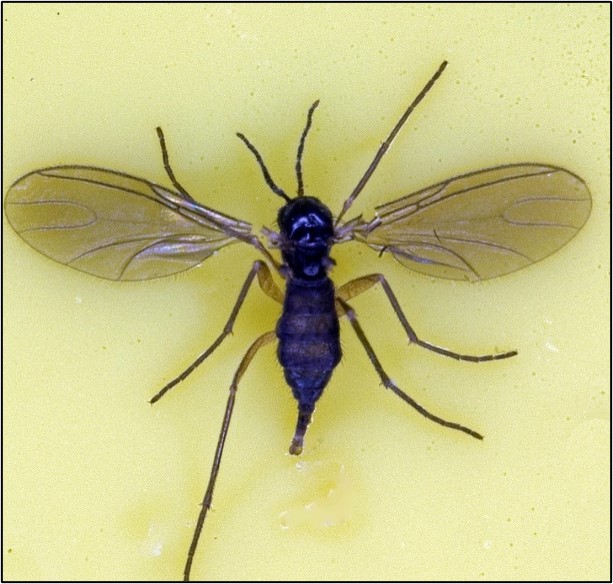
Figure 1: Fungus Gnat Adult
Identification
To control fungus gnats and shoreflies, you must be able to properly identify them; adult fungus gnats are dark, delicate-looking flies, similar in appearance to mosquitoes, with slender legs and long segmented antennae. As opposed to flying, they make short hops around the soil surface and will scatter quickly when disturbed, making identification of their presence easier to determine. Their wings are clear with a distinctive “Y” shaped vein (Figure 1). Fungus gnat larvae have a shiny black head and an elongated, whitish-to-clear, legless body which contrast well with most growing medias (Figure 2). The larval stage of fungus gnats predates on newly developing roots, ultimately slowing production time and increasing the risk of disease pressure.
Shorefly adults more closely resemble miniature houseflies. Compared to fungus gnats, shoreflies are stronger fliers, with shorter legs and antennae. Shoreflies have five distinctive clear-to-white spots on their wings (Figure 3). Shorefly larvae are also clear to white but lack a distinct head capsule. The pupal stage is dark brown with characteristic “fork” structure on one end. While shorefly adults can spread plant pathogens, the larvae are not directly damaging to plants.
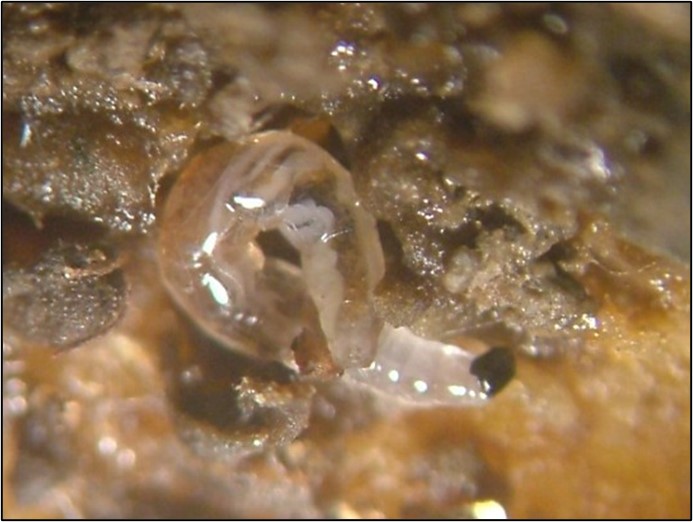
Figure 2: Fungus Gnat Larvae
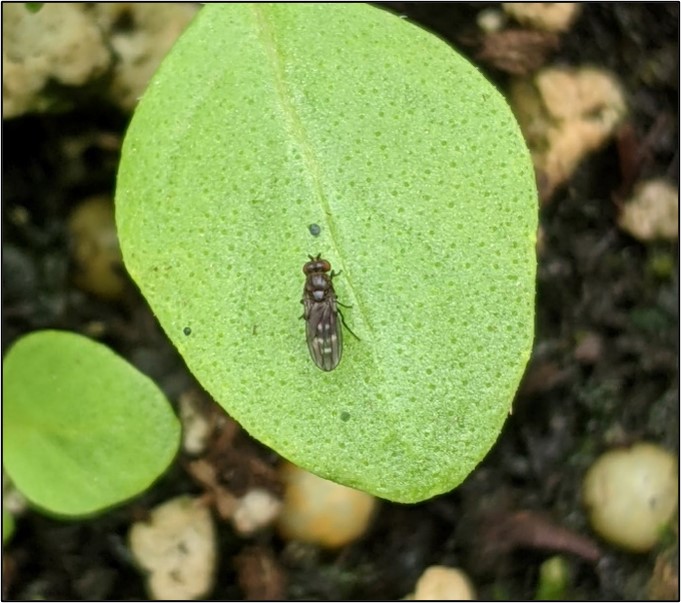
Figure 3: Shorefly Adult
Cultural Management
Habitat modification and sanitation are the first lines of defense against fungus gnats and shoreflies. Fungus gnats lay their eggs in cracks and crevices in the growing media. In greenhouses, this usually occurs on the surface of the soil but can happen in drain holes in the sides and bottom of pots as well. Constantly moist media and algae, which are common in propagation settings make a suitable habitat for fungus gnat larvae (Figure 4). Shoreflies thrive in standing water or waterlogged areas with abundant algae. The larval stage feeds on algae and the pupal stage is semi-aquatic, partially submerged in water. Moisture management, including improved drainage and taking steps to limit algae, can pay dividends by creating a less favorable habitat for both pests.
Power washing and approved cleaners such as Strip-It Pro can be used to remove organic matter from surfaces between crop cycles. After a thorough cleaning, sanitation products such as: KleenGrow, SaniDate 5.0, SaniDate 12.0, and ZeroTol 2.0 can be used to finish the job and ensure a clean start.
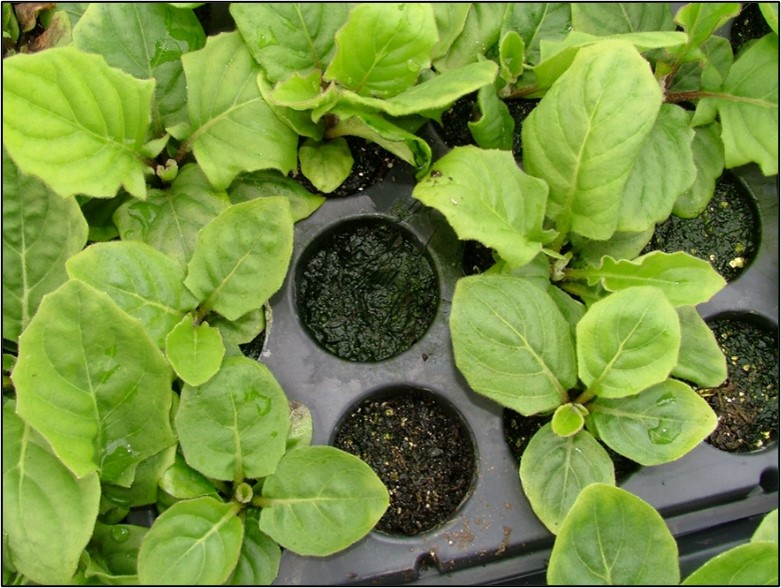
Figure 4: Algae Buildup in Propagation Tray
Chemical and Biological Control
Unfortunately, chemical control options for fungus gnats and shoreflies are very limited due to pesticide resistance. Beyond their ability to reproduce quickly in large numbers, these pests have been exposed to a wide range of chemistry over the years due to growers spraying for other insect pests. With this in mind, we should target the larval stage because control of adults isn’t very effective with available pesticides. The table below lists products recommended by GGSPro:
name(s) |
Ingredient |
Gnats |
|||
|---|---|---|---|---|---|
21 days of control |
|||||
vegetable transplants |
|||||
1 wk apart |
|||||
7-14 days |
|||||
vegetable transplants |
There are several biological control agents (BCAs) available on the market to combat these pests such as Dalotia coriaria, (aka Atheta or rove beetle), Stratiolaelaps scimitus (formerly known as Hypoaspis miles), and beneficial nematodes. For the sake of this article, we will focus on beneficial nematodes. Soil drenches of nematodes are highly successful in controlling the larval stages of fungus gnats and shoreflies. Choose Steinernema feltiae for fungus gnats and S. carpocapsae for shoreflies. Nematode treatments should be applied at least on a 3-week basis and can be applied to all types of crops and most types of growing media. Use yellow sticky cards to monitor for adult fungus gnats and shoreflies (Figure 5), and deploy the BCAs at the first sign of pest pressure. Contact GGSPro for further assistance on products, rate, and how these products appropriately.
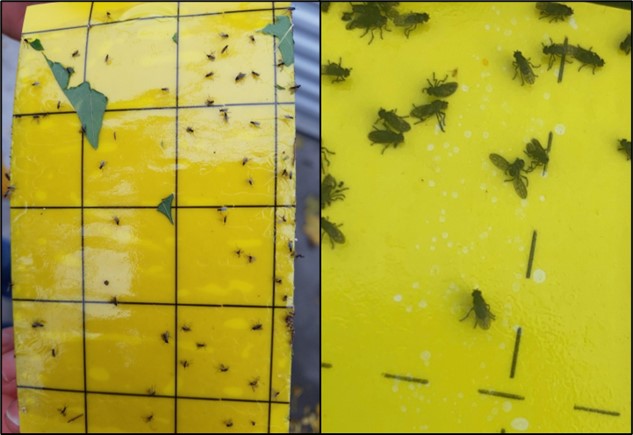
Figure 5: Fungus Gnat (R) and Shoreflies (L)
on Yellow Sticky Cards
Note, not all products are registered in all states. Some pesticides are restricted use in some states or regions and not others. It is the responsibility of the applicator to read and follow all label directions, remembering that labels may change. Other products may be safe and effective. Rates, application methods, and edible status are detailed in our GGSPro Insecticide & Fungicide Guides. Griffin also offers the 5th Edition GGSPro Technical Reference Guide in both English and now Spanish versions. This valuable resource outlines a wide range of pest control options along with information on pollinator safety, BCA’s, scouting, weed management, plant lighting, nutrition, water quality and more!
*Contact Griffin Greenhouse Supplies for product number and pricing information on BCA options
*Contact Griffin Greenhouse Supplies for product number and pricing information on BCA options